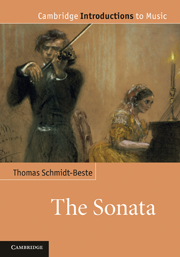Chapter 4 - Scoring and texture
Published online by Cambridge University Press: 05 April 2013
Summary
For what instruments were sonatas written, and what implications does instrumental scoring have for the structure, sound and texture of sonatas? These questions have not been foregrounded so far – but they are nevertheless crucial. We have seen, in particular, that scoring or instrumentation can play a decisive role in determining whether a composition can be called a ‘sonata’ in the first place, as opposed to, say, a canzona, a piano trio or even a sinfonia. These considerations can and do override formal aspects: an orchestral suite written c. 1700 can be more or less identical to a sonata in terms of the number and the internal structure of its movements. Only in exceptional cases – as, for example, in the sonata da chiesa – is a specific formal pattern associated with a particular type of sonata.
In contrast to the term ‘string quartet’, however, ‘sonata’ as such tells us nothing about the number and nature of the instruments involved. This necessitates the addition of further terms to qualify and specify the general designation – terms which may refer either to the number of instruments (‘sonata a 2’, ‘trio sonata’) or their types (‘piano sonata’, ‘violin sonata’).
- Type
- Chapter
- Information
- The Sonata , pp. 193 - 235Publisher: Cambridge University PressPrint publication year: 2011

